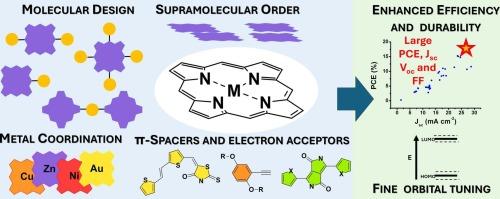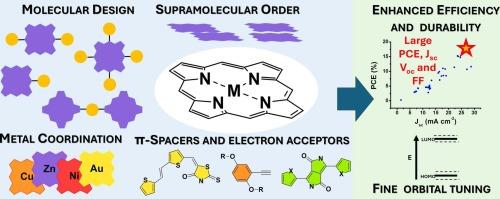Recent advances in the design of porphyrin-based architectures for organic solar cells: enhancing efficiency and performance
IF 23.5
1区 化学
Q1 CHEMISTRY, INORGANIC & NUCLEAR
引用次数: 0
Abstract
Porphyrins are π-conjugated materials with exceptional optical and electronic properties that have garnered considerable interest in the field of organic photovoltaics. Their well-established synthetic accessibility enables the construction of diverse molecular geometries through relatively few synthetic steps. This review highlights recent progress over the past decade in the rational design of porphyrin-based donor–acceptor architectures for third-generation organic photovoltaic devices. Emphasis is placed on the roles of molecular symmetry, π-extension, and donor–acceptor energy level alignment. Key structural features, including metal centers, side chains, and π-bridges, are examined in relation to their impact on device efficiency and operational stability. The influence of structural modifications on HOMO–LUMO energy levels, active layer morphology, and overall photovoltaic performance is critically assessed.


有机太阳能电池卟啉结构设计的最新进展:提高效率和性能
卟啉是一种π共轭材料,具有优异的光学和电子性能,在有机光伏领域引起了广泛的关注。它们完善的合成可及性使得通过相对较少的合成步骤构建不同的分子几何形状。本文综述了过去十年来在第三代有机光伏器件中基于卟啉的供体-受体结构的合理设计方面的最新进展。重点讨论了分子对称、π扩展和供体-受体能级排列的作用。关键的结构特征,包括金属中心,侧链,π桥,研究了它们对设备效率和运行稳定性的影响。结构修饰对HOMO-LUMO能级、活性层形态和整体光伏性能的影响进行了严格评估。
本文章由计算机程序翻译,如有差异,请以英文原文为准。
求助全文
约1分钟内获得全文
求助全文
来源期刊

Coordination Chemistry Reviews
化学-无机化学与核化学
CiteScore
34.30
自引率
5.30%
发文量
457
审稿时长
54 days
期刊介绍:
Coordination Chemistry Reviews offers rapid publication of review articles on current and significant topics in coordination chemistry, encompassing organometallic, supramolecular, theoretical, and bioinorganic chemistry. It also covers catalysis, materials chemistry, and metal-organic frameworks from a coordination chemistry perspective. Reviews summarize recent developments or discuss specific techniques, welcoming contributions from both established and emerging researchers.
The journal releases special issues on timely subjects, including those featuring contributions from specific regions or conferences. Occasional full-length book articles are also featured. Additionally, special volumes cover annual reviews of main group chemistry, transition metal group chemistry, and organometallic chemistry. These comprehensive reviews are vital resources for those engaged in coordination chemistry, further establishing Coordination Chemistry Reviews as a hub for insightful surveys in inorganic and physical inorganic chemistry.
 求助内容:
求助内容: 应助结果提醒方式:
应助结果提醒方式:


